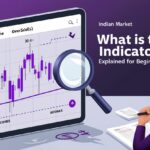Introduction: The Stock Market’s “Storytellers”
Imagine looking at a weather forecast. You don’t just see today’s temperature—you check trends: Was it hotter yesterday? Is rain coming?
Candlestick charts do the same for stocks. They don’t just show prices—they tell you the battle between buyers and sellers in a visual way.
But how do you read them? And why do traders swear by them? Let’s simplify it.
What Are Candlesticks?
Candlesticks are price charts that show 4 key details for a time period (1 min, 1 day, 1 week):
- Open – Starting price.
- Close – Ending price.
- High – Highest price reached.
- Low – Lowest price reached.
Visual Breakdown:
Upper Shadow (High)
┌───────────────┐
│ │ ← Body (Open/Close)
└───────────────┘
Lower Shadow (Low) - Green (Bullish) Candle → Close > Open (price rose).
- Red (Bearish) Candle → Close < Open (price fell).
Why Use Candlesticks?
✔ See market sentiment (greed vs. fear).
✔ Spot trends early (reversals, continuations).
✔ Better than line charts (more detail).
Example:
- A long green candle = Strong buying pressure.
- A long red candle = Heavy selling.
6 Must-Know Candlestick Patterns
1. Hammer (Bullish Reversal)
- Looks like: Small body, long lower shadow.
- Meaning: Sellers pushed price down, but buyers recovered it.
2. Shooting Star (Bearish Reversal)
- Looks like: Small body, long upper shadow.
- Meaning: Buyers pushed price up, but sellers rejected it.
3. Doji (Indecision)
- Looks like: Tiny/no body (Open = Close).
- Meaning: Buyers/sellers are equally matched.
4. Engulfing (Trend Reversal)
- Bullish Engulfing: Green candle swallows previous red candle.
- Bearish Engulfing: Red candle swallows previous green candle.
5. Morning Star (Bullish)
- 3-candle pattern: Long red → small candle → long green.
6. Evening Star (Bearish)
- 3-candle pattern: Long green → small candle → long red.
How Traders Use Candlesticks
1. Entry/Exit Signals
- Buy near hammer patterns.
- Sell near shooting stars.
2. Stop-Loss Placement
- Place stops below a hammer’s low (if buying).
3. Confirming Trends
- Multiple green candles = Uptrend likely to continue.
Limitations of Candlesticks
❌ Not 100% accurate – Use with other tools (trendlines, volume).
❌ False signals happen – Always use stop-losses.
Where to Practice?
✔ TradingView (free candlestick charts).
✔ Broker apps (Zerodha, Upstox).
Final Takeaways
✔ Candlesticks show Open, High, Low, Close.
✔ Green = Price rose | Red = Price fell.
✔ Patterns predict reversals/continuations.
✔ Combine with volume/trends for better accuracy.






